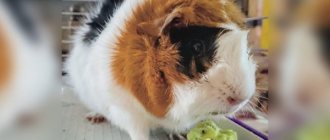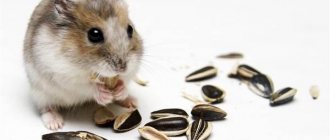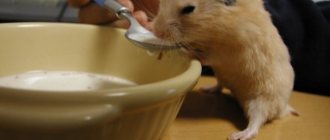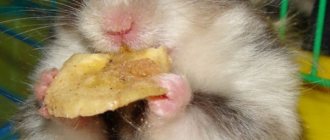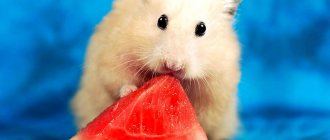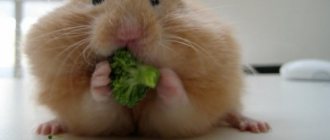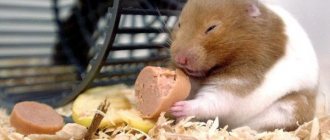Here he is! Large, beautiful, red and juicy bell pepper. I wonder if hamsters can have sweet peppers? It seems that they can’t have anything sweet, but we want our pet to grow up healthy. Vitamins are needed for health. Sweet bell peppers are full of them. So is it possible or not?
I wonder if I can eat this pepper?
About the benefits of bell pepper for hamsters
What are the benefits of bell pepper for hamsters? First of all, it is vitamin C. In terms of its content, pepper surpasses even lemon! Yellow fruits are especially rich in it. This is an excellent remedy for the prevention of scurvy, joint inflammation (very useful for Syrian hamsters), and various infections. Ascorbic acid is useful for pregnant females, and also for males for a faster “recovery” from stress.
Other useful vitamins and microelements:
- Retinol – improves metabolism, vision, hair and skin condition. It is he who is responsible for the red color of the fruit.
- Niacin – calms the nervous system, protects the skin and mucous membranes.
- Tocopherol – improves reproductive functions, accelerates the growth process.
- Lycopene – prevents the occurrence of tumors.
- Fiber is good for the digestive tract.
Which one is better to give?
The selection of sweet peppers is very large.
To figure out which one your pet will like, you need to know the difference between vegetables of different colors:
- red and orange fruits tend to be the sweetest and juiciest. They contain the most vitamins C and A;
- yellow pepper is a leader in the content of rutin, which is beneficial for blood vessels, in addition, it also has a sweet taste;
- green pods are considered low-calorie and useful for obesity, but their taste is slightly worse than the previous ones, and the peel is rougher.
Important! Despite the fact that the skin of bell pepper contains a lot of vitamins, it is recommended to remove it before giving the vegetable to your hamster to avoid irritation to the animal’s stomach.
It is better not to give boiled or canned product to hamsters. There are practically no useful substances left in boiled pepper, therefore, its use is pointless, and pickled pepper, in addition, also contains vinegar or other preservatives that can be harmful to the animal.
How to properly feed your hamster pepper
We choose only fresh peppers for feeding. No mold, not lethargic. For the first time, give a small piece, literally the size of a fingernail, and keep an eye on your pet. Give pepper to dzhungarikas especially carefully. This is a more gentle breed than the Syrians. Unfamiliar food may not do them any good.
Well, like little children, you have to taste everything.
Watch the animal. If no changes in his behavior and well-being have occurred within 2-3 hours, feel free to feed your Djungarian or Syrian hamster pepper.
Even if the first feeding was successful, this does not mean that you can throw a whole peppercorn into the cage and forget it for a week. Despite all the wealth of vitamins and other benefits, pepper cannot make up the majority of a rodent’s diet. This is a vitamin supplement. Not more. Bell pepper can be given to your hamster regularly in small pieces, a couple of times a week.
Care and maintenance at home
Keeping a Syrian hamster at home has a positive aspect - representatives of this breed are resistant to diseases. It follows from this that maintenance and care will not be difficult for rodent owners. The animals are loved by many for their kindness and habits.
Do Syrian hamsters bite?
Do hamsters bite? The answer to this question is unequivocal, yes they bite. But why does the Syrian hamster bite? The answer will be ambiguous. It all depends on the character of the animal or on your behavior towards it.
When purchasing, take a closer look at the character of your future pet. Whether a hamster bites or not will be visible almost immediately when you pick it up. And in the future, try not to cause him any inconvenience, and then you won’t have to suffer from his aggression.
Syrian hamsters - even a child can care for them at home. To do this, you should follow the basic, simple requirements and perform a number of procedures.
Timely cleaning of the cage at least twice a week is the main care for your hamster. When sawdust becomes dirty, it should be replaced with new ones. Food bowls and drinking bowls should be cleaned and washed daily, and for better effect and disinfection, pour boiling water over them.
Never use chemicals to clean a rodent's cage!
Is it possible to bathe a Syrian hamster?
The hamster itself does not require special care; it will take care of itself. The only thing that Syrians require is care for the fur and periodic combing. Bathing a hamster in water is extremely stressful for the animal. In order to clean the animal’s fur if it is heavily soiled, it is better to use a damp cloth, but if you still need to bathe the animal, then certain rules should be followed:
- bathe in warm water;
- the head, and especially the muzzle, should remain dry;
- After bathing, dry the animal’s fur with a hairdryer.
Read more about whether you can bathe hamsters and how to do it correctly here.
Cage for the Syrian
It is better to purchase a cage for a golden animal of medium size so that it can accommodate a sleeping house, a feeder and a drinking bowl. Considering that hamsters love to hide, play, climb and run, you should provide your pet with an “amusement park” by placing a swing, a running wheel and various driftwood in the cage.
Syrians are loners by nature (except for mating), so he is never bored and your pet will perceive loneliness as confirmation of care and love.
Remember, loneliness for the Syrian hamster is undeniable happiness.
This type of hamster is no different from other hamsters, which means it is nocturnal. He sleeps during the day and is awake at night. With the onset of dusk, the Syrian wakes up and leads a fairly active lifestyle, which can cause some inconvenience to the animal’s owners.
At night, a hamster can run about 7 kilometers. With this in mind, try to place your pet's cage away from the bedroom so that noise at night does not cause you any inconvenience.
Can a hamster have paprika?
The question is not entirely correct. Paprika is a spicy seasoning made from sweet (non-hot) varieties of capsicum. Who in their right mind would feed their pet dried pepper powder? I suspect these are the same people who come to the site with the request “can a hamster have beer or vodka?”
RESULT : Pepper can be given to Djungarian and Syrian hamsters. Even necessary. Introduce into the diet gradually, in small pieces. If all is well, feed the hamster pepper 2 times a week as a treat. The main diet of a rodent should be cereals (buckwheat for example) or legumes.
Bon appetit everyone!
What to do with pesticides?
The beautiful, glossy peppers sold in stores are usually loaded with chemicals. It is not recommended to treat small animals with such products. Store-bought vegetables may contain pesticides and toxic chemicals in huge concentrations, ensuring the safety of agricultural food. It is not always possible to buy pure pepper from a private farmstead, but you can process a store-bought product to reduce the content of harmful substances. To do this, it is enough to wash the fruit well, peel it, and remove the seeds. Only the pulp is placed in the hamster feeder, in which much less chemicals accumulate than in the skin and achenes.
Is it possible to give purchased fruits?
The products we take from stores or the market contain many additional “extra” chemical elements. Farmers treat apple trees with products to improve growth, large yields, and large, beautiful, juicy fruits. Fruit trees are also often sprayed with insect repellents. All this adds up to a mixture that is harmful even to the stomach of an adult. What can we say about the ventricle of a baby rodent?
Try to buy apples only from trusted sellers or grow them yourself in the garden. Try not to buy fruits grown near roads or polluted areas in large cities. Then the risk of poisoning the animal will be minimal. If this is not possible, try to neutralize the fruit as much as possible. Before use, rinse them thoroughly under running water, cut off the skin and place in water for several hours. This will remove most of the chemicals from the fruit.
It is important to choose not the most beautiful, rosy, large ones, but vice versa. Believe me, their taste and beneficial properties for the hamster will suffer.
Just don’t give sour varieties, because they contain too much harmful juice. But an unattractive appearance gives a high chance that chemicals were not used. “Wormy” fruits are considered especially clean.
Food Test (family test)
Match vocabulary words
containing salt as a flavoring -.
- dry wet sour starve hungry vitamin salty thirsty sweet bitter
those who want to drink -.
- dry wet sour starve hungry vitamin salty thirsty sweet bitter
feeling of need or desire for food -.
- dry wet sour starve hungry vitamin salty thirsty sweet bitter
wet - .
- dry wet sour starve hungry vitamin salty thirsty sweet bitter
having a sharp and unpleasant taste that is neither sour nor salty.-.
- dry wet sour starve hungry vitamin salty thirsty sweet bitter
without dampness, dampness or dampness: -.
- dry wet sour starve hungry vitamin salty thirsty sweet bitter
tart or sour taste, like lemon juice or vinegar.-.
- dry wet sour starve hungry vitamin salty thirsty sweet bitter
die or suffer from refusal to eat and drink.-.
- dry wet sour starve hungry vitamin salty thirsty sweet bitter
having a taste like honey -.
- dry wet sour starve hungry vitamin salty thirsty sweet bitter
natural or synthetic substances necessary in human nutrition to maintain health -.
- dry wet sour starve hungry vitamin salty thirsty sweet bitter
2.Fill in the blanks with a suitable option.
2. I can cook soup in two minutes, everything is ready.
3. The meat was in the oven.
- frying boiling frying grilling
4.Lemon taste.
- salty sour bitter crispy
5.No potato chips.
- crispy salty crispy juicy
6.If something is filled, it is.
- something you eat but you're still hungry delicious something you eat and feel full after eating it disgusting
7.Food eaten with hands.
- makes nails longer do they eat bad food in third world countries slang for a bad gesture is it food you can politely eat with your hands
8. Light food is the opposite.
- heavy food rich food soft food junk food
9.If something tastes good, you.
- I don’t really like it I think it’s delicious I hate eating it I only eat it for breakfast
10. Spicy food includes.
- milk lemons chili peppers hamburgers
11.If the milk is sour, it is so.
- delicious too old too fresh from goat
12. There is a drink.
- cognac alcoholic drink any drink non-alcoholic drink
13.They are all bitter, except...
- black coffee strong tea without sugar and milk unsweetened chocolate for baking pizza
14. Appetizing remedy.
- filling the first course in a restaurant nasty yummy
15. There is always nourishing food.
- salty expensive dessert fattening
Properties of the root vegetable
Carrots contain a lot of positive properties:
- This product contains vitamin A, which supports healthy bones, vision, and immune system.
- Vitamin K, which affects blood clotting.
- Vitamins C and B, without which the normal functioning of the body is also impossible.
- In addition to vitamins, it contains chromium, protein, iodine, phosphorus, calcium, carotene, and iron.
Another benefit of the root vegetable is due to the fact that it is a solid product. The hamster eats carrots and grinds down its teeth, which are constantly growing. These animals are constantly looking for something to chew; a piece of vegetable can replace a mineral stone.
It also contains a lot of juice, which quenches thirst well. If carrots appear regularly in the animal’s diet, then it will not have problems with dehydration.
The importance of fruits and vegetables for rodents
Fruits and vegetables are a source of nutrients not only for people, but also for their pets. Eating fresh vegetables normalizes the functioning of the digestive system. Fruits are a healthy treat that your hamster cannot refuse. Pets are fed plant products not only to satisfy hunger, but also to prevent vitamin deficiencies.
Vegetables and fruits are beneficial for hamsters because they contain:
- water;
- nutrients that provide energy;
- vitamins necessary to maintain immunity;
- minerals involved in metabolic processes;
- fiber that improves digestion.
All these components are necessary for the health of the pet. A long-term absence of one of these components leads to the development of various diseases.
Let's look into the greenhouse
Growing in a greenhouse requires a separate approach. Since there is little space in such rooms, and the spread of infections occurs faster, the selection of plants must be done more carefully.
When deciding what to plant with, gardeners consider two things: making the most of the space and preventing the development of diseases.
Let's see what is worth planting next to the bell pepper. Planting peppers next to onions is also acceptable in a greenhouse; you can find a place nearby for seedlings of zucchini, carrots, white cabbage or cauliflower. The latter type is preferable because it takes up less space.
The question of whether it is possible to plant similar crops next to each other, such as eggplants and tomatoes, is controversial. Since plants suffer from the same diseases, they can easily transmit them to each other, which in a confined space, especially with poor ventilation, threatens complete loss of the crop.
It is necessary to use this combination with great caution and do not forget about regular treatment of plants and soil. You can try varieties that are more resistant to pests
Nasturtium and chamomile, planted nearby, will have a beneficial effect on the main crop, increasing its productivity.
It is not recommended to plant peppers in a greenhouse next to cucumbers, since they have different requirements for growing conditions. Cucumbers need a high level of humidity, and the Bulgarian culture prefers dry and warm air; when combined, infections can develop.
Fennel and dill are not greenhouse plants and should not be planted next to pepper. The effect of fennel has already been described, and dill spreads so actively that it can interfere with other plants, in addition, its tall peduncles and large umbrellas prevent the pepper from receiving a sufficient amount of light. Dill can also become a source of carrot flies, which settle in its roots and are dangerous, first of all, for carrots, and its umbrellas become a refuge for aphids - dangerous for peppers.
Peas planted next to peppers, like beans and other legumes, are also very dangerous, so it is not recommended to plant legumes in greenhouses.
Thus, when deciding what can be planted next to pepper, you need to start from the compatibility of the crops and their influence on each other. Sometimes the list of things you can plant peppers with may seem strange, but more often this is proven data. You can get some information from your own experience and create your own list of combined plants.
